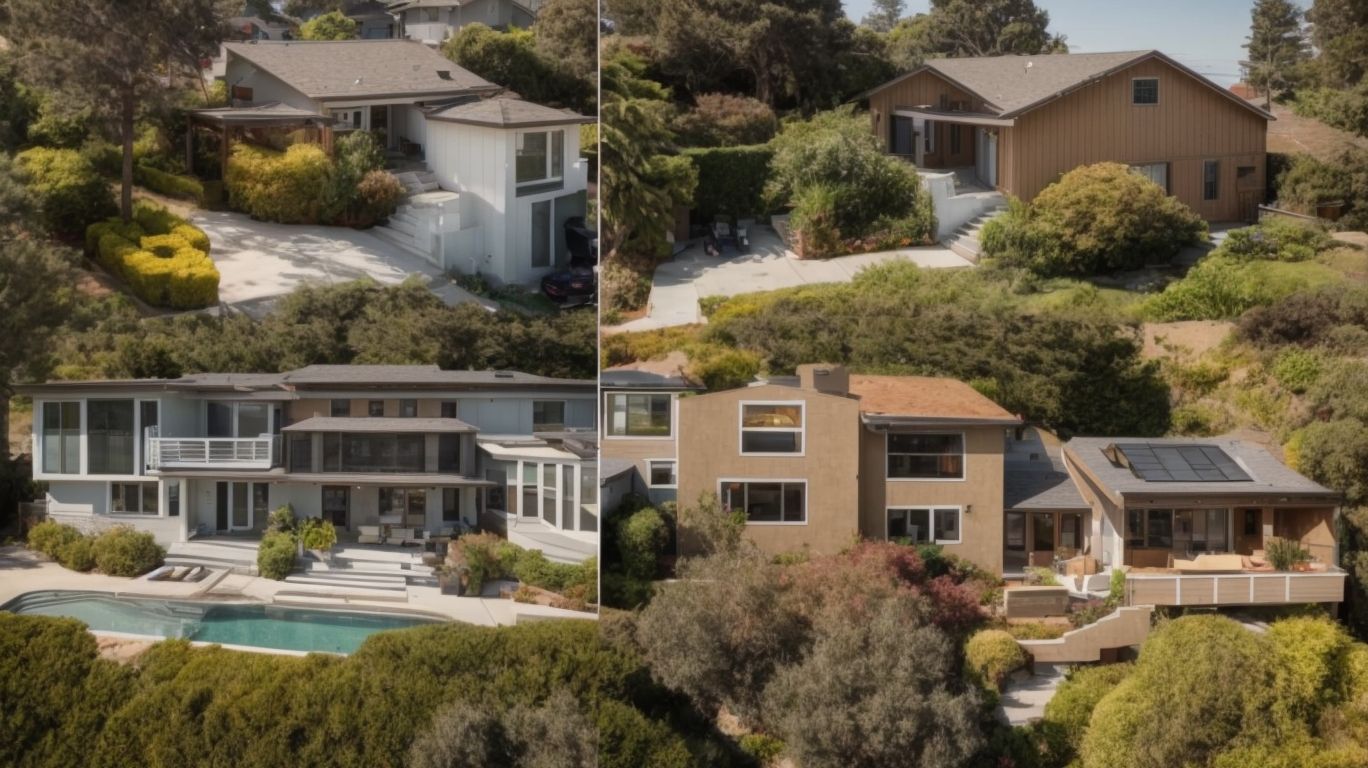
Before & After Magic: Transformative Second Story Additions in the Bay Area
Are you looking to expand your living space without the hassle of moving?
Second story additions could be the perfect solution for you.
We will explore the benefits of adding a second story to your home, the steps involved in the process, and important factors to consider before starting this transformative project.
Whether it’s to increase property value, personalize your home, or simply make room for a growing family, second story additions can work wonders for your living space.
What are Second Story Additions?
Transformative Second Story Additions are architectural enhancements to residential properties that involve adding a new level on top of an existing structure, creating additional living space and enhancing the overall design and functionality of the home.
These additions often provide homeowners with the opportunity to maximize land use by expanding upwards rather than outwards, which can be particularly advantageous in urban settings where space is limited.
From a design perspective, Second Story Additions allow for the integration of modern elements while maintaining the original character of the house, resulting in a seamless blend of old and new.
The newfound level not only increases square footage but also opens up endless possibilities for creative room layouts, natural light integration, and panoramic views.
Why Consider a Second Story Addition?
Considering a Second Story Addition for your home can bring about significant benefits in terms of home improvement, renovation, and transformation, enhancing both the aesthetics and functionality of the property.
One of the key reasons why homeowners opt for a Second Story Addition is the potential increase in living space without sacrificing yard space. This strategic approach allows for better utilization of the existing square footage, creating room for additional bedrooms, bathrooms, or even a dedicated office space. By expanding vertically, you can maximize natural light and ventilation throughout the house, leading to a more spacious and airy ambiance. Such transformations not only elevate the overall appeal of the property but also enhance its market value, making it a wise investment for the long term.
Increase Living Space
One of the key reasons to consider a Second Story Addition is to increase living space within your home, allowing for greater space utilization both internally and externally, and providing room for expansion and interior enhancements.
Expanding vertically with a Second Story Addition can significantly enhance the functionality of your living space. By adding a second level, you not only create more room for bedrooms, bathrooms, or a home office, but you also open up opportunities for creative design elements like vaulted ceilings and skylights. This upward expansion allows for a seamless integration of modern amenities and technologies, transforming the overall ambiance of your home. When considering interior and exterior space utilization, a Second Story Addition offers endless possibilities for maximizing your property’s potential.
Avoid Moving Costs
Opting for a Second Story Addition can help you avoid the substantial costs associated with moving to a new property, while simultaneously increasing the real estate value of your current home and enhancing its curb appeal.
This home improvement project not only saves you the expenses linked to relocating to a new house but also significantly boosts the market worth of your residence.
By adding a second story, you expand the living space, which is a major factor that potential buyers consider when assessing a property’s value.
The aesthetic appeal of your home is elevated through the addition of a second story, enhancing its overall attractiveness and potentially fetching a higher selling price in the future.
Investing in such upgrades proves to be a financially wise decision in the long run, as it can lead to substantial returns on your initial investment.
Increase Property Value
A Second Story Addition can significantly increase the property value of your home, provided that you obtain the necessary building permits, follow renovation tips from experts, and execute the project with attention to detail and quality workmanship.
- By adhering to the proper permit process, you ensure that your project meets all local regulations, safeguarding your investment and preventing any potential legal issues in the future.
- Renovation tips such as optimizing natural light, utilizing energy-efficient materials, and creating a cohesive design aesthetic can further enhance the appeal and value of your second-story addition.
- Attention to detail not only ensures a seamless integration with the existing structure but also adds a level of sophistication and quality that elevates the overall value of your property.
Personalize Your Home
A Second Story Addition offers you the opportunity to personalize your home according to your preferred architectural style, incorporating custom design elements that enhance the aesthetic appeal and overall uniqueness of your property.
Whether you lean towards a modern, minimalist look or a more traditional, classic vibe, the flexibility of Second Story Additions allows you to tailor your space to reflect your personal taste. From choosing the roof pitch that complements your style to selecting materials that speak to your design aesthetic, the customization options are limitless. By blending architectural elements seamlessly with your unique vision, you can create a space that not only reflects your personality but also uplifts the overall charm and sophistication of your home.
What are the Steps Involved in a Second Story Addition?
Undertaking a Second Story Addition project involves several crucial steps, including meticulous planning, efficient project management, selection of appropriate construction materials, and detailed architectural plans to guide the construction process smoothly.
- To begin with, in the planning phase, it is essential to assess the structural integrity of the existing building and ensure that it can support the additional weight of the new story. This may involve consulting with structural engineers to determine any necessary reinforcements.
- Project management strategies play a vital role in coordinating different aspects of the construction timeline, such as obtaining permits, scheduling inspections, and dealing with contractors.
- The selection of construction materials is another critical consideration, with factors like durability, cost-effectiveness, and aesthetic appeal influencing decisions.
- Architectural plans serve as a roadmap, detailing the layout, dimensions, and design elements to ensure that the end result meets both functional and aesthetic requirements.
Consultation and Planning
The initial phase of a Second Story Addition involves consultation with experienced professionals, meticulous planning, accurate budgeting, and leveraging local expertise to ensure a comprehensive and successful project outcome.
- Consultation and planning are crucial aspects when embarking on a Second Story Addition.
- Budgeting considerations play a pivotal role in determining the feasibility of the project, ensuring that costs are accurately estimated and managed throughout the construction process.
Local expertise can provide valuable insights into regulatory requirements, architectural styles, and construction norms specific to the area, ultimately enhancing the overall design and functionality of the addition. Professional consultation also helps in identifying potential challenges early on, allowing for proactive solutions and a smoother project execution.
Obtaining Permits
Securing the necessary building permits for a Second Story Addition involves compliance with building codes, adherence to zoning regulations, and establishing a realistic construction timeline to meet regulatory requirements and ensure project progress.
- Navigating the permit acquisition process starts with understanding the specific building codes relevant to your project, ensuring that the design and construction plans align with these regulations.
- Zoning regulations dictate how the property can be used and developed, impacting the height, setback requirements, and overall aesthetics of your Second Story Addition. It is crucial to engage with local authorities early on to clarify any zoning restrictions and secure the necessary approvals.
- A detailed construction timeline not only helps in managing the project efficiently but also demonstrates your commitment to completing the addition according to the specified guidelines.
Demolition and Structural Changes
The phase of demolition and structural changes in a Second Story Addition project requires the expertise of a structural engineer to ensure the integrity of the existing structure and implement changes that not only enhance living space but also increase the property value.
A skilled structural engineer plays a crucial role in evaluating the structural viability of the existing foundation, walls, and load-bearing elements before any alterations are made. By conducting thorough assessments and calculations, they can recommend appropriate modifications to support the additional weight of the added story. These structural enhancements not only contribute to the safety and longevity of the property but also add significant value to the home, making it a wise investment.
Meticulous planning is essential to navigate through zoning restrictions and building codes to ensure a successful and compliant project.
Framing and Roofing
The framing and roofing phase of a Second Story Addition project focuses on enhancing energy efficiency, selecting appropriate construction materials, and modernizing the property’s infrastructure to align with contemporary standards and sustainable design practices.
During this phase, it is crucial to pay attention to insulation materials and techniques that can greatly impact the energy efficiency of the new addition. Opting for materials like high-quality fiberglass insulation or spray foam insulation can help reduce heat loss and energy consumption.
Incorporating energy-efficient roofing materials, such as cool roofs or reflective shingles, can contribute to reduced cooling costs and overall environmental impact. Modernization efforts in this phase might also involve installing solar panels or integrating smart home technology to further enhance sustainability and functionality of the property.
Electrical, Plumbing, and HVAC
Incorporating electrical, plumbing, and HVAC systems in a Second Story Addition project is essential to ensure optimal functionality, timely project completion, and the engagement of skilled craftsmen to handle the intricate installation processes.
These essential systems play a crucial role in enhancing the overall comfort, convenience, and efficiency of the newly added space. Functional requirements such as proper lighting, effective climate control, and efficient water supply are indispensable for creating a livable and enjoyable environment.
Timely completion of these system installations is vital to avoid delays in the construction timeline and ensure the smooth progression of the project. Skilled craftsmen bring their expertise to the table, executing the installations with precision and quality craftsmanship to guarantee the safety and effectiveness of these fundamental systems.
Insulation and Drywall
The insulation and drywall phase of a Second Story Addition project demands quality workmanship, effective insulation solutions, and adherence to renovation trends to ensure energy efficiency, structural integrity, and aesthetic appeal in the final construction.
Installing high-quality insulation and drywall in second-story additions is crucial not only for maintaining comfortable indoor temperatures but also for reducing energy costs. Opting for energy-efficient insulation practices can significantly lower heating and cooling expenses while promoting sustainability.
Staying up-to-date with contemporary renovation trends ensures that the project aligns with modern design aesthetics, increasing the overall value of the property. Proper insulation and drywall installation play a key role in creating a well-insulated, visually appealing space that meets the demands of today’s homeowners.
Flooring, Fixtures, and Finishing Touches
The final stage of a Second Story Addition involves installing flooring, fixtures, and adding finishing touches that not only enhance the aesthetic appeal but also contribute to customer satisfaction through innovative solutions and attention to detail.
During this phase, focus shifts towards carefully selecting flooring materials that complement the overall design scheme. Whether it’s luxurious hardwood, trendy laminate, or stylish tiles, each choice is made with the client’s preferences in mind.
Fixtures such as lighting fixtures, faucets, and hardware are meticulously installed to add functionality and style to the newly renovated space. The incorporation of innovative design solutions, such as smart home technology or eco-friendly features, showcases a commitment to modern living standards, ensuring that the customer’s needs and desires are met beyond expectations.
What Factors to Consider Before Starting a Second Story Addition?
Before embarking on a Second Story Addition project, it is crucial to consider factors such as obtaining a detailed cost estimate, effective project management strategies, and engaging experienced builders to ensure a successful and satisfactory construction process.
Thorough cost estimation is key in setting realistic budget expectations and avoiding financial surprises during the project. Project management practices play a vital role in ensuring that timelines are adhered to, resources are efficiently utilized, and potential issues are mitigated swiftly. Experienced builders bring a wealth of knowledge and skill to the construction site, enabling them to address complexities that may arise during the second-story addition with expertise and finesse.
Budget
Setting a realistic budget is a critical factor to consider before starting a Second Story Addition project, as it influences project completion timelines, planning accuracy, and overall financial management throughout the construction process.
By establishing a clear budget from the outset, homeowners can mitigate the risk of overspending and encountering financial setbacks mid-project. A well-defined budget not only helps in allocating resources effectively but also ensures that the project stays on track in terms of timelines and deliverables. Proper budgeting allows for better decision-making during the construction phase, enabling adjustments to be made without sacrificing quality or incurring unnecessary costs. Ultimately, effective budget planning sets the foundation for a successful Second Story Addition, reflecting the importance of financial foresight in achieving desired outcomes.
Zoning Restrictions
Understanding and complying with zoning restrictions are imperative considerations before commencing a Second Story Addition, as adherence to regulations not only enhances property value but also ensures compliance with local building codes for a seamless construction process.
Zoning regulations play a crucial role in dictating the size, height, setbacks, and overall design of a property. Ignoring these mandatory guidelines can lead to costly fines, legal issues, and even jeopardize the safety of the structure.
By aligning the Second Story Addition plans with the specific requirements set by the local authorities, homeowners can safeguard their investment and maintain the integrity of the neighborhood. Adhering to building code compliance guarantees that the construction meets necessary safety standards and quality inspections, ultimately creating a reliable and functional living space.
Structural Integrity of Existing Home
Assessing the structural integrity of the existing home is paramount before initiating a Second Story Addition, as it determines the need for any structural modifications, the acquisition of relevant building permits, and establishing a realistic construction timeline to ensure project success.
By conducting a thorough structural assessment, homeowners can identify potential weaknesses in the current structure that may impact the second-story addition. This evaluation also informs the necessary structural modifications that need to be made to support the additional load.
Obtaining the required building permits is crucial to comply with local regulations and ensure that the project meets safety standards.
A well-defined construction timeline plays a vital role in coordinating various tasks, managing resources efficiently, and completing the project within the set timeframe.
Timeline and Disruption to Daily Life
Considering the project timeline and potential disruption to daily life is crucial when planning a Second Story Addition, requiring effective project management strategies, sustainable design practices, and a well-structured construction timeline to minimize inconvenience and ensure project efficiency.
This careful planning is essential for orchestrating a successful construction project that maximizes efficiency and minimizes inconvenience for the homeowner. Sustainable design considerations play a vital role in reducing the environmental impact of the addition, ensuring that the project aligns with eco-friendly practices.
By incorporating sustainable materials and energy-efficient solutions, the Second Story Addition can not only enhance the living space but also contribute to a greener and more sustainable future. A structured construction timeline helps in coordinating various tasks effectively, ensuring that different phases of the project are completed in a timely manner to avoid unnecessary delays and disruptions in daily life.




No Comments